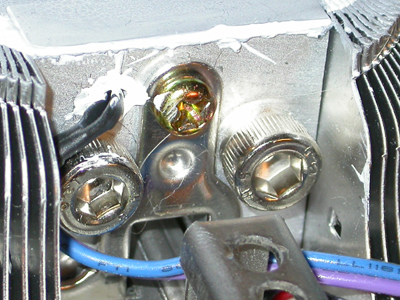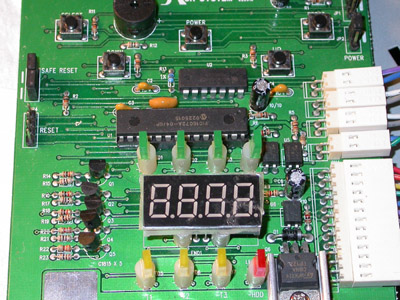CPU Heat Comparison: How Hot is Prescott?
by Derek Wilson on April 16, 2004 4:32 AM EST- Posted in
- CPUs
Heatsink Modding: The New Rage
Our solution to the problem is admittedly a bit of a kludge. Nothing is perfect, but we really wanted numbers that were going to get us some useable data, so we needed to get as close to measuring the surface temperature of a processor as possible.We decided to drill a hole in a heatsink and drop in a thermister.
Our heatsink of choice was the Zalman CNPS7000A-AlCu. In order to get something consistent between processors, we wanted to measure the temperature at the center of the heatsink close to the surface that would contact the processor. We drilled in from the side of the block to the center of the copper strip. Since the retention mechanism was held in by a screw in the center of the side, we had to go in at an angle. Please do not try this at home, as flying metal shards and angled drilling into a block of metal are not things we want to be sued over should something go wrong. Here's a look at what we ended up with:

This is a close up of the side of our modded heatsink.
This heatsink fit on all the processors we wanted to test, and we were assured that degrading its cooling ability a little by drilling a hole in it would still allow it to keep the CPUs cool enough to run. We hooked up a thermistor that came with a case we had, and since it was already set up for displaying temps, we forewent building a reader for it ourselves and just ripped out the front panel as well.

This is the front panel display we used to read the temperatures.
Some care needs to be taken when reading the data that we collected using this heatsink. First of all, this isn't a measure of the heat output of a processor. This is a measurement of the temperature at a specific position in an open system. Having the misfortune of suffering through a thermodynamics class in college isn't always a bad thing (except with respect to one's GPA), but what this means is that these numbers still aren't perfect. The processor is heating the bottom of the heatsink, while the fan is cooling the rest of it. Even though the heat is being distributed through the heatsink, if there is a hot or cold spot very close to the position from which the thermister was reading temperatures, the data could be off for that particular processor. Because we are heating and cooling this object at the same time, the equilibrium temperature we find at this position may not be directly proportional to the heat output of the chip.
But, with all that said, this is still better than using the on die thermistor or monitoring change in system temperature. Our tests were performed in a temperature controlled room with no case on the computer. In order to load the processors, we ran two simultaneous instances of Prime95 for 40 minutes (though temperatures stabilized after about 25). Our idle temperatures were taken after powering up and doing nothing for 30 minutes (no power saving options were enabled).










48 Comments
View All Comments
AMDScooter - Friday, April 16, 2004 - link
Quote:"Boy, some of you guys are cruel assholes and belong in Tomshardware and not in anandtech with your attitudes."Most of us here are not mindless zealots who believe everything we read. We post what we feel are valid rebuttals to an article, so we are asshoels now..?? Whatever. At the very LEAST the article is a bit misleading. I can see no other point to the article other than getting uninformed peeps like Icewind to buy Prescotts... My2c.
BTW, dont mistake my name for bias. I currently run a 3.2c in a Vapo unit and am very happy with it.
steller2k - Friday, April 16, 2004 - link
Having some background in thermodynamics, electrical theory and computers (The Navy slang term was Nuc Electrician). It occurs to me that the Prescott processor itself may not be much hotter than the Northwood. The lower voltages would lower the losses in the die reducing the amount of heat there, offset by the increased current requirements and increased losses due to the closer proximity of the transitors, hence roughly the same performance. The biggest problem as I understand it is the motherboards themselves overheating. The term is I^2R losses, as current increases the actual heat generated in other power supply and motherboard components are squared, or in other words if current requirements are doubled the heat produced is four times the original amounts. Don't get me wrong, I really like Anandtech and I found this article surprising and informative; I didn't expect the temperatures on the Prescott and Northwood to be that similar. But I think in the future that for a clearer picture of total heat cost of a processor should include measurement of the the ambient case temperatures. An interesting side note: the higher temperatures of the P4s helps them to dissapate more heat than the lower temperatures of the Athlons, of course that only works up to the point that the rest of the computer doesn't melt. ;) I'm trying to think of a few ways to measure the true heat cost of a certain set of components, but most of what I'm thinking would require some significant mods or a custom/purpose built case. (Like the heater used for heatsink testing mentioned above).Relatively happy owner of an AMD Athlon 64 FX, if only there were some worthwhile apps and Socket939 had been a launch item... <sigh>
AnonymousPutterer - Friday, April 16, 2004 - link
Crouscant, you might like to see some notes on my rather sloppy DIY rig, featuring precisely measured flow rates and temps before and after:http://www.crystalfontz.com/forum/showthread.php?s...
TauCeti - Friday, April 16, 2004 - link
I just don't get what the author of this article wanted to measure. Was it the temperature of the die in combination with a specific cooler?If it was about _heat output_, why not just measuring the power 'usage' of the CPU? I think about 100% of the 'used' electrical energy is converted to thermal heat _inside_ the case because it does not look like the CPU radiates HF-waves and induces heat _outside_ the case?!
I just don't get it.
klah - Friday, April 16, 2004 - link
Add another graph showing the idle temps of the A64 with C'n'Q enabled.Icewind - Friday, April 16, 2004 - link
Boy, some of you guys are cruel assholes and belong in Tomshardware and not in anandtech with your attitudes.Sahrin - Friday, April 16, 2004 - link
Pardon my lack of a degree in thermodynamics, but isn't there a significant difference between heat dissipated and temperature? We were shown that the effectiveness of heat distribution negatively impacted the XP's quite significantly (and this is further supported by the fact that they didn't increase percentage-wise in temperature anywhere near as much as the heatspreader processors did)...aren't there possibly other factors here? Intel said the TDP for Northwood was...what, 89 as I recally? And TDP (this is an average, not a maximum) for the Prescott is 103W, and it is speculated that Prescott at times will dissipate as much as 130W? Isn't this what is important...? (I may just be running in circles here) The amount of heat put out into the volume of the case...the heat doesn't just disappear, it fills the volume of the case and then is blown out (or ideally, is blown out before it has a chance to dissipate within the case)...this is the reason for the BTX standard, new huge coolers the LGA etc. etc. etc. Right?AMDScooter - Friday, April 16, 2004 - link
Speaking of stoopid. Intel must have floated him a good size check to write this article saying the Prescott is not much hotter than the Northwood. The whole article reeks of Intel PR hard at work. WTF kind of testing methodology is his temp probe in a heatsink BS?? All the chips he tested have an on die temp sensor, but he takes all his readings from a hole drilled in the heatsink?? What a load of bunk. I thought Anand had finally grown up as he has not written an article this biased in some time. For a few minutes there I thought I had accidently stumbled onto Tom's site. So at this point our choices are to believe the rest of the world(myself included) and forum members all over in saying the Prescott is hot as h3ll or.... believe Anand and run out and buy a cool running 3.2E.... and watch it melt our MOBO's.Jeff7181 - Friday, April 16, 2004 - link
Whew... glad... I thought I might have been the only one who read this and thought "huh?"This doesn't appear to be your best work, Derek.
Coruscant - Friday, April 16, 2004 - link
Maybe some suggestions on how to better measure the heat load of the processors. Providing a mass flowrate of coolant across the processor sufficient to cool the processors to a set temperature, and with the coolant having a known inlet temperature condition, measuring the outlet temperature would provide a reasonably accurate measurement of the heat generated. Considering how commonplace liquid cooling has become, certainly this setup wouldn't be out of the question. All that would be required would be a refrigeration loop, adequately insulated coolant reservoir, variable speed pump, and several (3) thermistors. Just a suggestion, from a mechanical/process engineer.